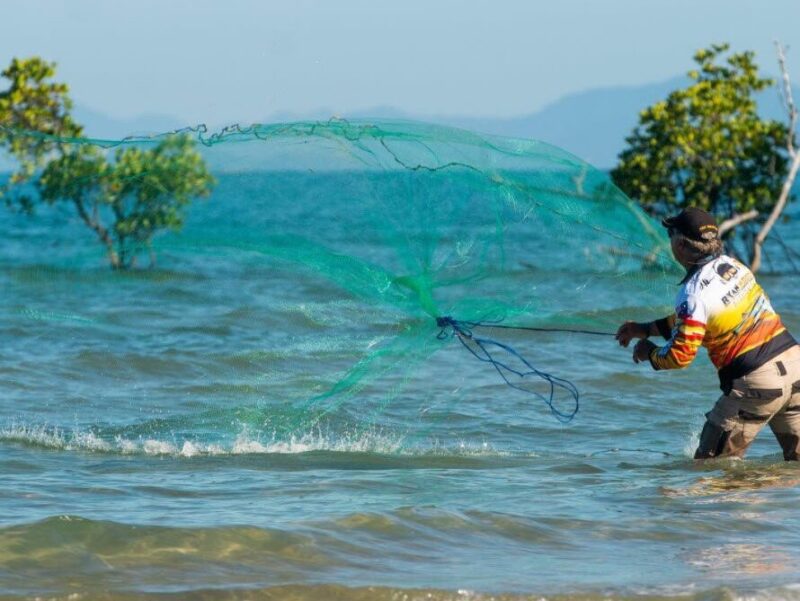As the saying goes, “Give a man a fish and you feed him for a day; teach a man to fish and you feed him for a lifetime.” This holds true for the popular sport of fishing, where the skills and techniques acquired through practice and experience play a crucial role in catching fish.
Among the many forms of fishing, Momo Fishing has gained widespread popularity in recent years. Originating from Japan, this method combines traditional fishing with modern technology, making it an exciting and challenging activity for fishing enthusiasts. Momo Fishing involves using a remote-controlled boat with a fishing line attached to it, allowing for greater precision and control over the bait placement.
If you are new to Momo Fishing or looking to enhance your skills, then you have come to the right place. In this article, we will share some valuable tips and techniques that can help you become a pro at Momo Fishing. So, grab your gear, hop on your boat, and let’s dive into the world of Momo Fishing!
Outline:

- [Understanding Momo Fishing](
understanding-momo-fishing)

- History and Evolution of Momo Fishing
- How Momo Fishing differs from Traditional Fishing
- Benefits of Momo Fishing
- [Choosing the Right Equipment](
choosing-the-right-equipment)

- The Remote-Controlled Boat
- Fishing Rod and Reel
- Bait and Lures
- Additional Equipment
- [Mastering the Techniques](
mastering-the-techniques)

- Controlling the Boat
- Casting the Line
- Jigging Technique
- Retrieval Technique
- Fighting the Fish
- [Finding the Perfect Spot](
finding-the-perfect-spot)

- Understanding Water Conditions
- Identifying Potential Hotspots
- Tips for Scouting and Marking Fishing Spots
- [Dealing with Common Challenges](
dealing-with-common-challenges)
- Wind and Currents
- Tangles and Snags
- Underwater Obstacles
- [Safety Measures](
safety-measures)
- Rules and Regulations
- Precautions to Take while Fishing
- Emergency Preparedness
Understanding Momo Fishing
Before we dive into the tips and techniques, it is essential to have a basic understanding of what Momo Fishing is all about.
History and Evolution of Momo Fishing
Momo Fishing originated in Japan in the early 2000s, and it quickly gained popularity among fishing enthusiasts due to its unique approach. It was initially developed as a way to fish in small, crowded water bodies without disturbing other anglers. However, with advancements in technology, Momo Fishing has evolved into a competitive sport, with tournaments being held worldwide.
How Momo Fishing differs from Traditional Fishing
The main difference between traditional fishing and Momo Fishing lies in the use of a remote-controlled boat. In traditional fishing, the angler casts the line and waits for a fish to bite, whereas in Momo Fishing, the bait is controlled by a remote-controlled boat. This allows for more precise placement of the bait and the ability to cover a larger area.
Moreover, traditional fishing often requires the angler to be physically present near the fishing spot, whereas in Momo Fishing, the angler can control the boat from a distance. This makes it a more convenient and enjoyable experience, especially in adverse weather conditions.
Benefits of Momo Fishing
Apart from the convenience and precision offered by Momo Fishing, there are several other benefits that make it a popular choice among anglers. Here are some advantages of Momo Fishing:
- Increased Accuracy: With the ability to control the movement and placement of the bait, Momo Fishing offers greater accuracy, resulting in more successful catches.
- Exploring New Spots: As the angler does not need to be physically present near the fishing spot, Momo Fishing allows for exploring new locations and water bodies, expanding the opportunities for a good catch.
- All-Weather Fishing: Bad weather can often ruin a traditional fishing trip, but with Momo Fishing, one can continue fishing even in adverse weather conditions as long as the boat can handle it.
- Safety: The angler does not need to wade into the water or climb onto rocks to fish, making it a safer alternative to traditional fishing.
- Eco-Friendly: Unlike traditional fishing, where lines and baits may get lost or discarded, Momo Fishing uses a remote-controlled boat to retrieve the bait, making it an eco-friendly option.
Now that we have a basic understanding of Momo Fishing let’s move on to some essential tips for mastering this unique method of fishing.
Choosing the Right Equipment
The key to success in Momo Fishing lies in choosing the right equipment. From the remote-controlled boat to the fishing rod and bait, every aspect plays a crucial role in catching fish. Let’s take a look at some essential equipment for Momo Fishing.
The Remote-Controlled Boat
The core of Momo Fishing is the remote-controlled boat, also known as an RC boat. This boat is responsible for carrying the bait and maneuvering it in the water. When choosing an RC boat for Momo Fishing, consider the following factors:
- Size: The size of the boat should be appropriate for the type of water body you will be fishing in. A smaller boat is ideal for small ponds and streams, while a larger one is better suited for lakes and rivers.
- Speed and Maneuverability: Look for a boat that can move swiftly and make sharp turns. This will allow for better control over the bait.
- Stability: The boat should be able to handle the weight of the bait without tipping over or losing balance.
- Battery Life: Choose a boat with a long battery life to ensure uninterrupted fishing sessions.
It is also essential to practice controlling the boat before heading out for fishing to get used to its movements and controls.
Fishing Rod and Reel
Momo Fishing involves casting the line from the RC boat, which means that you need a fishing rod and reel suitable for this purpose. Here are some things to consider when choosing a fishing rod and reel:
- Length: The length of the rod should be appropriate for the size of the fish you are targeting and the water body you will be fishing in.
- Power and Action: The power of the rod refers to its ability to bend under pressure, while action refers to how much of the rod bends. For Momo Fishing, a medium-power rod with fast action is ideal.
- Material: Graphite and fiberglass are the most common materials used for fishing rods. Graphite rods are lightweight and sensitive, making them a popular choice for Momo Fishing.
- Reel Type: Spinning reels are more suitable for Momo Fishing as they can handle lighter lines and lures effectively.
Bait and Lures
When it comes to bait and lures, there is no one-size-fits-all solution. The type of bait and lure you use will depend on the type of fish you are targeting and the water conditions. Here are some popular bait and lure options for Momo Fishing:
- Crankbaits: These lures mimic the movement of smaller fish and are perfect for attracting predator fish.
- Soft Plastic Worms: These are versatile lures that can be used for various types of fish and water conditions.
- Live Bait: Using live bait, such as worms or minnows, can be a highly effective way to attract fish. However, it also requires more skill and effort to keep the bait alive and in place.
- Artificial Baits: These include a variety of lures designed to mimic the movement and appearance of live bait without the need for constant maintenance.
Always carry a variety of baits and lures with you to see what works best in different situations.
Additional Equipment
Apart from the essential equipment mentioned above, there are a few other items that you may need while Momo Fishing. These include:
- Line Cutters: A sharp pair of line cutters is essential for quickly removing tangled lines or cutting off caught fish.
- Tackle Box: A well-organized tackle box can save you a lot of time and frustration while searching for the right lure or bait.
- Sun Protection: Make sure to carry sunscreen, sunglasses, and a hat to protect yourself from the sun’s harmful rays.
- First Aid Kit: Accidents can happen anytime, so it is always wise to carry a small first aid kit with you.
Choosing the right equipment for Momo Fishing is crucial as it can make a significant difference in your success rate. Take your time to research and invest in good quality equipment that will last you a long time.
Mastering the Techniques
Once you have all the necessary equipment, it’s time to learn the techniques involved in Momo Fishing. Here are some tips to help you master the skills required for this unique method of fishing.
Controlling the Boat
The first and most crucial step in Momo Fishing is learning to control the boat effectively. Here are a few things to keep in mind:
- Familiarize yourself with the controls of the boat before heading out into the water.
- Start by practicing in a small water body with calm waters to get used to the boat’s movements.
- Use the remote to move the boat in small increments to avoid spooking the fish.
- Keep an eye on the battery life of the boat and recharge it as needed to prevent any disruptions in your fishing session.
Casting the Line
Casting the line from the RC boat is slightly different from traditional casting. Here’s how you can perfect this technique:
- Hold the rod with your dominant hand and the remote with the other hand.
- Use the remote to maneuver the boat to the desired location.
- While keeping the boat steady, use your dominant hand to cast the line.
- Make sure that the bait or lure is not too close to the boat, as it may scare away the fish.
- Practice different casting techniques, such as sidearm and overhand casts, to find what works best for you.
Jigging Technique
Jigging involves making the bait move up and down in the water to attract fish. It is an effective technique for catching predator fish such as bass and pike. Here’s how you can master jigging:
- After casting the line, use the remote to slowly lower the bait into the water.
- Once the bait has reached the desired depth, use short, sharp movements to make the bait move up and down.
- Maintain a consistent rhythm while jigging to make the bait look more natural and attractive to fish.
- Experiment with different jigging techniques and speeds to see what works for the type of fish you are targeting.
Retrieval Technique
Retrieving the line is another crucial technique in Momo Fishing. Here’s how you can do it effectively:
- Once you have caught a fish or decide to change your lure, use the remote to bring the boat closer to you.
- Ensure that the boat is close enough for you to reach the line with your fishing rod.
- Use the remote to slowly retrieve the line while reeling in the slack with your fishing rod.
- Take your time and avoid jerky or sudden movements that may scare away the fish.
Fighting the Fish
The last and perhaps most exciting part of Momo Fishing is fighting the fish. Here’s what you need to know:
- When a fish bites, use the remote to pull the boat in the opposite direction gently.
- Use your fishing rod to keep steady pressure on the line while slowly reeling in the fish.
- Avoid pulling too hard on the line, as it may cause the fish to break free.
- Keep your hand steady on the fishing rod and use your body weight to fight larger fish.
Mastering these techniques may take some time and practice, but once you get the hang of it, you will be able to catch more fish with ease.
Finding the Perfect Spot
Along with having the right equipment and skills, finding the perfect fishing spot plays a crucial role in your success at Momo Fishing. Here are some tips to help you find the perfect spot:
Understanding Water Conditions
The first step to finding a good fishing spot is understanding the water conditions. Factors such as water depth, temperature, and clarity can significantly impact fish behavior. As a general rule, fish tend to stay close to structures like rocks, trees, and drop-offs, so look for these when scouting for potential spots.
Identifying Potential Hotspots
Apart from structures, other factors can indicate potential hotspots for fish. These include:
- Currents: Fish tend to gather in areas with strong currents as it brings them food and oxygen.
- Vegetation: Underwater vegetation provides shelter and food for fish, making it an excellent spot for fishing.
- Underwater Features: Rocks, gravel beds, and other underwater features attract smaller fish, which attracts predator fish.
Tips for Scouting and Marking Fishing Spots
- Take your time to explore different areas of the water body to see where the fish are more active.
- Use a fish finder or other navigation tools to identify underwater structures and features.
- Keep a record of your previous fishing spots and the catches you made to help you plan future trips.
Remember that fishing spots may vary based on the time of day, weather conditions, and season, so be open to exploring new areas and trying different techniques.
Dealing with Common Challenges
As with any sport, Momo Fishing also comes with its own set of challenges. Here are some common obstacles you may face while Momo Fishing and how to deal with them:
Wind and Currents
Strong winds and currents can make Momo Fishing challenging, as they can push the boat off course and affect bait placement. In such situations, it is crucial to:
- Use the remote to keep the boat steady in the direction of the wind or current.
- Adjust the speed of the boat to match the strength of the wind or current.
- Use heavier weights or lures to prevent them from being blown away by the wind.
Tangles and Snags
Fishing lines getting tangled or caught in underwater debris is a common problem experienced by anglers. To avoid this, try these tips:
- Use appropriate weight for the depth of the water and the strength of the currents.
- Keep the line taut while retrieving to avoid it getting caught on underwater debris.
- Learn how to untangle lines quickly and invest in good quality line cutters.
Underwater Obstacles
Underwater structures, rocks, and vegetation can often pose a challenge while Momo Fishing. Here’s how you can deal with them:
- Use the remote to maneuver the boat around the obstacle and avoid getting the line caught.
- If possible, move to a different spot where there are fewer obstructions.
- Invest in a good quality line that can withstand the pressure of navigating around obstacles.
Remember, practice makes perfect, and the more you fish, the more you will learn to deal with these challenges effectively.
Safety Measures
Last but not least, ensuring your safety while Momo Fishing should be a top priority. Here are some safety measures you should take while indulging in this sport:
Rules and Regulations
Before heading out for fishing, make sure to familiarize yourself with the rules and regulations of the water body you will be fishing in. This includes obtaining necessary permits and licenses and following any restrictions on bait, catch limits, or seasons.
Precautions to Take while Fishing
- Always wear a life jacket, especially if you are fishing in deep or fast-moving water.
- Carry a whistle or other signaling devices to call for help if needed.
- Avoid wading into water unless necessary, and if you do, make sure to wear appropriate footwear to prevent slipping.
- Be mindful of the weather conditions and head back to shore if there is a risk of lightning or strong winds.
Emergency Preparedness
Despite taking all the necessary precautions, emergencies can happen. Make sure you are prepared for such situations by carrying the following items:
- A fully charged phone to call for help if needed.
- Basic first aid supplies.
- An emergency kit with snacks, water, and warm clothing.
It is also recommended to have a fishing buddy or inform someone about your whereabouts before heading out for a fishing trip.
Conclusion
Momo Fishing is an exhilarating and challenging activity that requires a combination of skill, patience, and the right equipment. By following the tips and techniques mentioned above, we hope you can enhance your skills and catch more fish while enjoying this unique method of fishing. Remember to always prioritize safety and follow rules and regulations while fishing to ensure a fun and memorable experience. So, grab your gear, hit the waters, and try out these tips for playing Momo Fishing!







